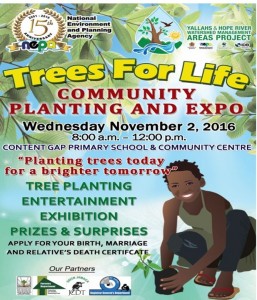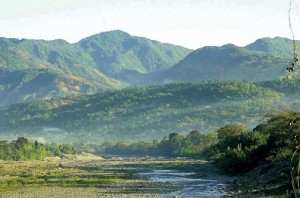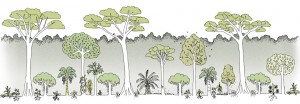
Trees R Us: Our Sustenance and Water Supply
October 31st, 2016
I am looking forward to joining a group of enthusiastic workers from the National Environment and Planning Agency (NEPA) this week. We will be traveling up into the Blue Mountains, to a place called Content Gap in St. Andrew, where NEPA and its partners will engage in a pretty major tree-planting exercise at the Primary School and Community Centre. I am also hoping to do some birding, so will be armed with my binoculars.
These kinds of activities are not mere symbolism. Especially if young people are involved, they light a spark. The physical activity is important, including the experience of actually getting one’s hands into the earth and pressing down the roots of a young tree into it. It also inspires teamwork. Young people like doing things together, with minimum supervision. Once they are shown what to do, the adults can stay in the background.
The Trees for Life activity is in support of a precious – and I would say, endangered – watershed area that supplies much of the fresh water needed by the greedy urban sprawl that is the city of Kingston. Or rather, I should say, thirsty. This is the Yallahs and Hope River Watershed Management Areas Project, which in April this year was allocated a sum of J$65.5 million from the Global Environment Facility (GEF) and the Jamaican Government. It is working on developing a database (hardware and software); scientific assessments of the area; and plans to reforest 100 acres of degraded public lands.
While all this important work is going on, it is critical – to my mind – to engage communities, in particular the farmers and the youth (the younger the better, I believe). Changing hearts and minds is not an overnight thing. Nor is adapting or changing practices that have developed over years and become ingrained – practices and traditions that have become unsustainable.
However, there is nothing like this phrase “better together.” It sounds rather political, but by this I mean that farmers and other groups that have many issues and experiences in common can – and must – work together and support each other while learning new techniques and ways of looking at their environment. It cannot be a case of “doing your own thing” any longer. I recently read about a system set up in Uganda, which is apparently working very well. Particularly aimed at Ugandan woman farmers, Adaptive Collaborative Management (ACM) “is an approach whereby stakeholders who share an interest in a common natural resource agree to act together to plan, observe and draw lessons from the implementation of their plans. It is characterized by conscious efforts among such groups to collaborate, resolve conflicts, and seek opportunities to learn collectively about the impacts of their actions.” This sounds like something that could work in Jamaica, does it not?
The event up in the hills of Content Gap is not, of course, just about water. Food security is becoming an increasingly pressing issue. With climate change, “unseasonal” seasons, and the droughts and floods persistently disrupt and damage our agriculture. This is perhaps especially true in our mountainous areas, which are so prone to landslides and vulnerable to storms. I understand that most of the trees to be planted this week in Content Gap will be fruit trees. So, this will be a “multi-purpose” activity: providing food when the trees begin to bear (and perhaps helping create a new cottage industry later down the line); helping to anchor the steep mountainsides, preventing soil erosion; and of course mitigating the effects of climate change and drought by providing water. It is a winner all round. I hope also that some slower-growing native trees will be planted. We need to encourage biodiversity in this way, too, because that benefits us all.
It will be enjoyable and instructive, up in the mountains. We city dwellers will get a morning full of fresh air and exercise. Much more importantly, I would like to congratulate NEPA on their ongoing (and often unrecognized) efforts to educate and sensitize Jamaicans across the island on a range of issues – with limited resources.
Let the tree-planting begin!
Tags: agriculture, agroforestry, Content Gap, deforestation, food security, fruit trees, Global Environment Facility, mountains, National Environment and Planning Agency, NEPA, St. Andrew, sustainable development, tree planting, trees, Uganda, water resource management, watershed, Yallahs and Hope River Watershed Management Areas Project
The Gleaner reserves the right not to publish comments that may be deemed libelous, derogatory or indecent.
To respond to The Gleaner please use the feedback form.
6 Responses to “Trees R Us: Our Sustenance and Water Supply”
- We Are the Zoomers
- Living Online with Humans and Birds: NAOC 2020
- Human Trafficking and the Problem of Public Education
- Down Memory Lane
- Are We Ready to Recover from COVID-19?
- Road Safety Matters: Is Your Vehicle Safe?
- Sexual Harassment, Me Too, and the Minister’s Disturbing Giggle
- The Vulnerable Senior Citizens, Private Care Homes and COVID-19
- A Muddle Over Masks
- Here is Something Life-Saving You Can Do: Give Blood!







I would agree, wholeheartedly with fruit, but you really need to allow natural forest growth in watershed areas, so as to allow rainwater to percolate through and bind the soil, so as to build the aquifer
Thank you for your comment, Jeremy! Yes, I agree. As you noted before, if the land around the fruit trees is cleared this cannot happen. I hope we will be planting some native trees, because there is not much forest cover in this area I understand. That is the problem.
Some fruit trees such as mango and coconut – etc may not do well or fruit at that altitude so trees that are indigenous to the area will have to be planted. Bamboo can help to bind soil together to help to cut down soil erosion – the Dendrocalamus or large type clumps together and may not do as well as the Phyllostachys or slim type as it spreads fast and grows thick and may help to cover area faster than most other trees can.
Yes – good point, Tandy. I actually did see mango trees in the area, although it’s so high up and they did plant mango trees yesterday, as well as naseberries, cherry, apple and more (not coconut). They are also rehabilitating deforested land with native trees (not fruit trees). The problem with the bamboo is that some species are invasive so the Forestry Department says that it tries to keep it in check, although there were clumps here and there. They are also avoiding planting more pine because it apparently does not bind the soil well.
Ha – mis typed Emma, lol – -Coconut prob would do well plus would bind the soil well – I hope the fruits they planted will bear fruit since I’ve seen an area in Mandeville Manchester with mango -naseberry – soursap and pomegranate that just grows but not produce fruit until recently when it got warm due to the drought – apple should do well. The smaller type of bamboo like I have here does not clump and is very invasive and would bind soil well and is why I suggested but guess they dont want it – prob could spread 15 ft per yr with regular rainfall. Though they’d want it because of its fast coverage and drought tolerance. Lots of vine plants may help too but they should know what works best.
That’s the thing – drought tolerant is good but I guess because this is a watershed restoration project that is perhaps not the main priority. Having said that, last year bush fires came very close to the community (on each side). The past two years of drought have been quite a wake up call for the community – especially for the farmers, of course. They recognize the importance of trees as a way of improving and securing this watershed. The sign for Trees For Life is in the shape of a drop of water.